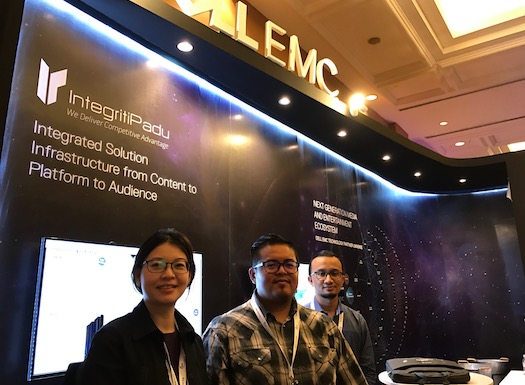AsiaRadioToday attended technical sessions and took a walk around some of the more interesting exhibitors at the Digital Broadcasting Summit.
Here is what we found.
DellEMC
Dell and EMC have merged to form the largest privately controlled tech company in the world. With the merger, the company now has a new range of services available for broadcasters.
DellEMC’s Charles Servior told delegtes at DBS2017 about the new products on display at the company stall in the exhibition.
“We’ve all been through technology transitions in the past. The current focus is IP transition, which brings enormous agility and efficiencies.”
“Software is now far more general purpose and it gives broadcasters the opportunity to future proof themselves by adopting a new approach.”
At the heart of modern workflows has to be high quality storage, and DellEMC uses the latest storage technology to help broadcasters store and process content more efficiently. “Media data centres need to be flexible enough to take advantage of the constant changes in technology,” said Servoir.
The company’s Isilon product is the first all-flash storage solution available to broadcasters and is being displayed at the symposium. It can be used to improve server storage and processing.
The new product does not make older platforms obsolete, and is backwards compatible, so that broadcasters do not have to completely replace all their old hard drives, they can stage their replacement process more intelligently, to get better performance where it is needed, but to be able to use their old systems to continue storing or processing other parts of the process.
When is the tipping point when you should replace all your hard drives with flash storage systems? Analysing cost effectiveness Servior anticipates that the tipping point will be in a few years time. “But for now, add the flash storage to your current system and get a huge performance boost and improvement, then plan for complete replacement in the next few years. It is evolutionary…
“This next transition is not just swapping boxes, it is a transformation across your business model,” he said.

Emotion Systems
In the same session, M C Patel from Emotion Systems discussed how broadcasters can outsource their audio processing to his company, which automates audio file based processing tasks, resulting in quicker and cheaper processing costs.
Some of the main functions done by Emotion Systems include: loudness correction, track mapping, Dolby E Encoding, extracting mix and effects, adding or removing audio channels, language versioning.
“We automate some of the non creative audio editing processes that tie up studios and production staff on low level processing jobs,” he said.
In an example of how the system works, he discussed a client who mixes the files then puts it in a ‘watch folder.’ Emotion Systems picks up the file and processes it, outsourcing the workflow of routine processing tasks.
“The old way was to do it in house or outsource to a post production house, now that process can be automated and outsourced differently. In this example we changed the turn around time from 2 days to a few hours and we made it cheaper for the client,” said Patel
World DAB Exhibition
Solid State Logic mixing desk
Zenon video products for radio
Titus II DRM digital radio
Managing Director of Megahertz Ltd Jon Flay talked about the importance of systems integration in moving broadcast businesses forward. Megahertz designs, engineers and delivers turnkey systems to the world’s leading broadcasters, content owners and media service providers.
Designing new studios or investing in new technology is no longer just a job for the engineering department, it should become an opportunity for the business to drive change and look for improvements. Flay’s company works in Europe and Asia integrating the technical and business objectives of technological change for broadcasters. His advice is to consider the balance between capital and operating expenditure. In the past when a broadcaster considers new technology, they considered buying equipment, but now there are alternatives such as cloud storage and browser based apps, where you may not need to buy storage or software, but you will have to pay for usage or pay an operating fee. In many cases this may be a better solution then making one big capital expenditure investment in technology that may be outdated quickly.
“Some workflows are working well in the cloud, remote services are becoming part of our operations now. You can expand for big events and contract when the demand is lower.
“New technology is not just a technical project any more, you must have a strategy to implement operational change as well,” said Flay.
In his conference he outlined the priorities that most broadcasters are currently facing when they refit studios.

